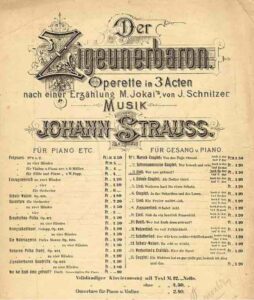Johann Strauss II (1825-1899) Einzugsmarsch aus der Operette Der Zigeunerbaron / Entrance March from Operetta The Gipsy Baron, o. op.

Im Sommer 1885 schrieb Johann Strauß dem Librettisten des “Zigeunerbarons: „Der Einzugsmarsch muss großartig werden. Etwa 80 – 100 Soldaten (zu Fuß, zu Pferde), Marketenderinnen (in spanischer, ungarischer, wienerischer Toilette), Volk, Kinder mit Buschen und Blumen, welch letztere sie den heimkehrenden Kriegern streuen etc. etc. müssen erscheinen.“ Dieser Vision für die grandiose Empfangsszene für die aus dem Spanischen Erbfolgekrieg zurückkehrenden Soldaten im dritten Akt als Nr. 17 der Operette “Der Zigeunerbaron” entsprach auch der schneidige Einzugsmarsch, der am 24. Oktober 1885 zum ersten Mal das Publikum im Theater an der Wien zu jubelndem Applaus begeisterte. In den seither vergangenen Jahren hat der Marsch an mitreißendem Schwung nichts eingebüßt.

In the summer of 1885, Johann Strauss wrote to the librettist of the “Gipsy Baron”: “The entry march must be magnificent. About 80-100 soldiers (on foot, on horseback), sutlers (in Spanish, Hungarian, Viennese dress), people, children with bushes and flowers, which the latter they scatter for the returning warriors etc. etc. must appear.” This vision for the grandiose reception scene for the soldiers returning from the War of the Spanish Succession in the third act as No. 17 of the operetta “The Gypsy Baron” also corresponded to the dashing entrance march, which for the first time inspired the audience in the Theater an der Wien to cheering applause on October 24, 1885. In the years that have passed since then, the march has lost none of its rousing momentum.
| sound sample / Tonbeispiel | score/parts PDF download: € 15,- | add to cart / in den Warenkorb |
